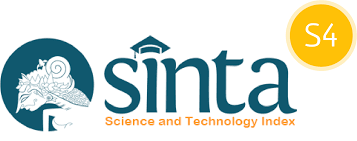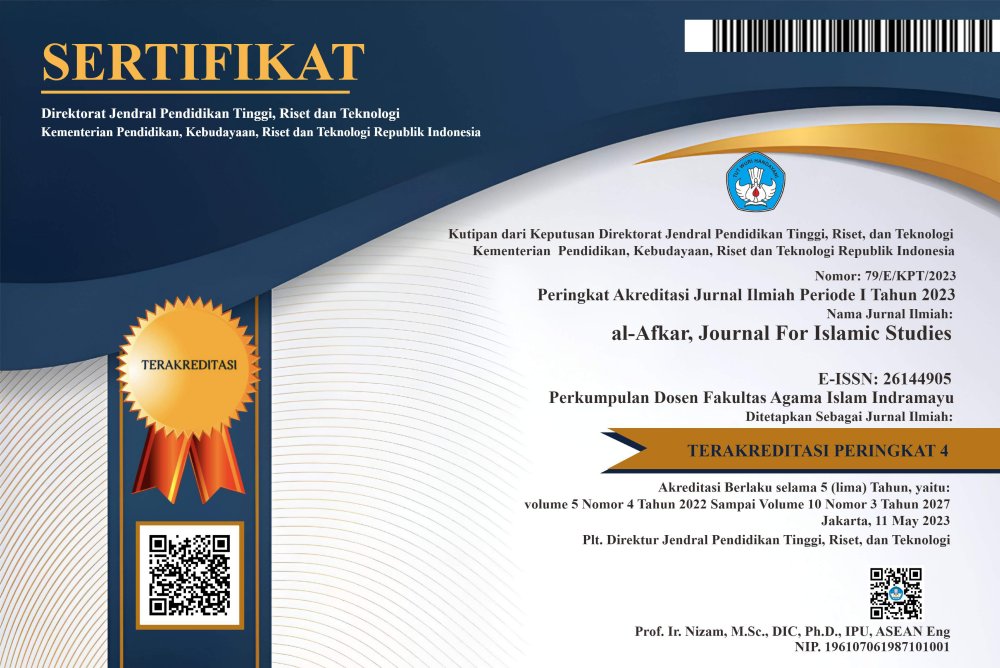The Existence of the Dhikr Tradition Before Migrating In the Perspective of Religious Anthropology
DOI:
https://doi.org/10.31943/afkarjournal.v6i3.681Keywords:
Existence, Dhikr Tradition, Society, Anthropological Perspective of ReligionAbstract
The purpose of this research is to look at the dhikr tradition before going away, especially the background of the community always implementing it every year, and to find out the existence of the application of the dhikr tradition before going away by the people of Wakan Village, Jerowaru District, East Lombok Regency, when their children are going to go abroad. This study uses qualitative methods by collecting data through in-depth observation and interviews with parents and young people aged 20-30 years, as well as using previous research that is relevant to this research. The results of the study show that the tradition of dhikr before traveling is a hereditary tradition from the ancestors of the people in Wakan Village. In implementing the tradition of dhikr before going abroad, it becomes a forum for the community to pray for children who go abroad with the aim of a journey to study knowledge that can run smoothly. As well as the impact presented in implementing the dhikr tradition is able to become a social glue for society among other communities, and is able to become the ethos of young people in carrying out their education so that it can be completed quickly. Thus the tradition of dhikr before traveling can become part of religious anthropology, because this tradition is closely related to the religious teachings and culture of the community in Wakan Village, Jerowaru District, East Lombok Regency.
Downloads
References
ADELIA, RAHMAWATI. “TRADISI DZIKIR DALAM MUJAHADAH DI PONDOK PESANTREN PUTRI ROUDLATUL QUR’AN 3 LAMPUNG TIMUR.” Undergraduate, UIN Raden Intan Lampung, 2021. http://repository.radenintan.ac.id/15315/.
Agus, Bustanuddin. Agama dalam Kehidupan Manusia: Pengantar Antropologi Agama. Jakarta: Raja Grafindo Persada, 2006.
Aribowo, Bayu. “Religiusitas Pendengar Dzikir Di Media YouTube.” Al-Balagh : Jurnal Komunikasi Islam 6, no. 1 (26 Agustus 2022): 32–47. https://doi.org/10.37064/ab.jki.v6i1.12635.
Azhari, Sukron, dan Sukardiman. “Eksistensi Tradisi Mertuq Pada Masyarakat Sasak Di Desa Wakan Kecamatan Jerowaru Kabupaten Lombok Timur.” Jurnal Sosiologi Agama Indonesia (JSAI) 2, no. 2 (30 Juli 2021): 111–18. https://doi.org/10.22373/jsai.v2i2.1490.
Bunganegara, Muadilah Hs. “Pemaknaan Shalawat: Pandangan Majelis Dzikir Haqqul Yaqin.” Tahdis: Jurnal Kajian Ilmu Al-Hadis 9, no. 2 (2018). https://doi.org/10.24252/tahdis.v9i2.12478.
Creshwell, Jhon W. Research Desaign , Qualitative, Quantitative, And Mixed Methods Approaches, Dterjemahkan oleh Achmad Fawaid dan Rianayati Kusmini Pancasari. Yogyakarta: Pustaka Pelajar, 2021.
DURKHEIM, EMAIL. THE ELMENTARY FORMS OF THE RELIGIOUS LIFE. Yogyakarta: IRCiSoD, 2017.
Geertz, Clifford. Abangan, Santri, Priyayi dalam Masyarakat Jawa. Jakarta: Pustaka Jaya, 1983.
HARSOJO, PROF. PENGANTAR ANTROPOLOGI. BANDUNG: FA. EKONOMI BDG, 1967.
Haryanto, Rudy. “DZIKIR: PSIKOTERAPI DALAM PERSPEKTIF ISLAM.” AL-IHKAM: Jurnal Hukum & Pranata Sosial 9, no. 2 (2014): 338–65. https://doi.org/10.19105/al-lhkam.v9i2.475.
Huda, Alamul. “FENOMENA DZIKIR BERJAMAAH SEBAGAI SARANA PEREKAT SOSIAL.” Jurisdictie: Jurnal Hukum Dan Syariah, no. 0 (2011). https://doi.org/10.18860/j.v0i0.2163.
In’amuzzahidin Masyhud, 1977-. Berdzikir dan sehat ala Ustadz H. Hariyono. Semarang: Syifa Press, 2006.
Iskandar, Yusuf. “SEJARAH DAN PERKEMBANGAN TRADISI DZIKIR FIDA’ DI DESA KINCANG KECAMATAN RAKIT KABUPATEN BANJARNEGARA.” JSI: Jurnal Sejarah Islam 1, no. 1 (27 Juli 2022): 111–28. https://doi.org/10.24090/jsij.v1i1.6457.
KONTOWIJOYO. BUDAYA DAN MASYARAKAT. Yogyakarta: TIARA WACANA YOGYA, 2006.
Maran, Rafael Raga. Manusia dan kebudayaan dalam perspektif ilmu budaya dasar. Jakarta: Rineka Cipta, 2007.
Marlina, Murni Eva, Payerli Pasaribu, dan Daniel H. P. Simanjuntak. Antropologi Agama. Yayasan Kita Menulis, 2020.
Maulidya, Erine Nur. “DAMPAK FENOMENA CLUBBING DI TINJAU DARI DIMENSI AGAMA DAN MASYARAKAT.” Al-Adyan: Jurnal Studi Lintas Agama 10, no. 2 (2015): 231–50. https://doi.org/10.24042/ajsla.v10i2.1431.
Moleong, Lexy J. METODE PENELITIAN KUALITATIF. BANDUNG: PT REMAJA ROSDAKARYA, 2013.
Noer, Deliar. Pemikiran Politik Islam Santri. Jakarta: Panjimas, 1986.
Oktaviani, Andella, Yuni Maryuni, dan Arif Permana Putra. “Perkembangan Kesenian Dzikir Saman Di Desa Wanagiri Kecamatan Saketi Kabupaten Pandeglang Tahun 1998-2017.” Reslaj : Religion Education Social Laa Roiba Journal 4, no. 3 (31 Januari 2022): 780–803. https://doi.org/10.47467/reslaj.v4i3.944.
pals, daniel l. seven theories of religion: tujuh teori agama paling berpengaruh. Yogyakarta: IRCiSoD, 2018.
Rasikin, Ela Hikmah Hayati dan H. Revitalisasi Seni Budaya Dzikir Saman Di Desa Kubangkondang, Kecamatan Cisata-Pandeglang-Banten. GUEPEDIA, t.t.
Rosidah, Feryani Umi. “Pendekatan antropologi dalam studi agama.” Religió: Jurnal Studi Agama-agama 1, no. 1 (Maret 2011): 23–32.
Saikuddin, Akhmad. “TRADISI ZIARAH MAKAM SYEKH AL-BADAWI DI DESA DUKUHTENGAH BREBES PERSPEKTIF SAKRALITAS EMILE DURKHEIM.” An-natiq Jurnal Kajian Islam Interdisipliner 2, no. 1 (7 Maret 2022): 84–93. https://doi.org/10.33474/an-natiq.v2i1.14248.
Sholichah, Nur Hidayatus. “Tradisi Dzikir Dalam Ritual Keagamaan Thoriqoh Qodiriyah Wa Naqsyabandiyah Di Desa Punggul Gedangan Sidoarjo.” Undergraduate, UIN Sunan Ampel Surabaya, 2018. http://digilib.uinsby.ac.id/24796/.
Subki, Muhammad, dan Sukron Azhari. “Pertentangan Integritas Anak Petani dalam Pekerjaan di Era Modern.” Jurnal Ilmu Sosial dan Humaniora 12, no. 1 (30 April 2023): 120–28. https://doi.org/10.23887/jish.v12i1.56474.
SUGIYONO. METODE PENELITIAN, KUANTITATIF, KUALITATIF, DAN R&D. BANDUNG: CV ALFABETA, 2009.
Suteja. Tradisi Amaliyah Warga NU : Tahlilan - Hadiyuan Dzikir Dan Ziarah Kubur. Vol. 1. c: Aksarasatu, 2015. http://www.repository.syekhnurjati.ac.id.
Wakhid, Moh Rizalul. “Tradisi Dzikir Dalam Ritual Keagamaan Majelis Dzikir Wa Ta’lim As-Habul Yamin Semolowaru Surabaya.” Undergraduate, UIN Sunan Ampel, 2019. http://digilib.uinsby.ac.id/36784/.
Downloads
Published
How to Cite
Issue
Section
License
Copyright (c) 2023 Azis Efendi, Sukron Azhari, Masroer Ch.Jb, Pratiwi Nur, M. Akzomi Zakawali

This work is licensed under a Creative Commons Attribution-NonCommercial 4.0 International License.



















